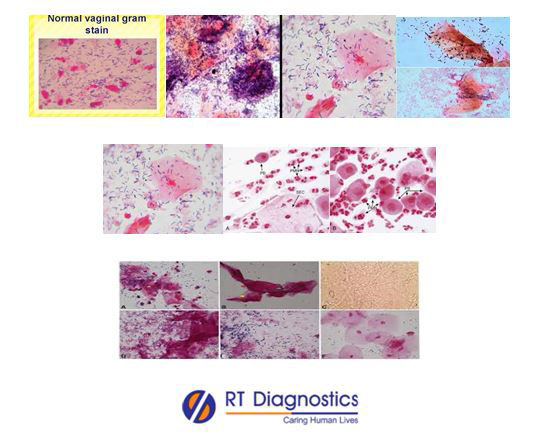Gram Stain- Vaginal Smear:
Why Gram Stain (Vaginal Smear) Test?
CLINICAL INFORMATION
Bacterial vaginosis, Trichomoniasis and vulvovaginal candidiasis are the most common infectious causes of vaginitis. Vaginal swabs are taken to test for infections caused in the female genital tract, which when ignored might ascend up and can affect kidneys leading to its associated diseases (eg. pyelonephritis) and also eventually result in endo-cervix and pelvic inflammatory diseases (vaginal or cervical infection can also extend up to the uterus, fallopian tubes, ovaries and to the entire pelvic area). The symptoms can vary from abnormal vaginal discharge, irregular bleeding, pelvic pain, Urethritis etc. Hence apart from vaginal swabs, another related specimen may also be collected for the purpose such as a swab of cervix, aspirated endocervix, urethral discharge etc. As a part of a routine check-up, the tests for sexually transmitted diseases also becomes mandatory (during conception to prevent TORCH infection) in diseases related to the female reproductive organ. The usual microbial pathogens are either bacteria (eg.Chlamydia trachomatis – Gram-negative bacteria, Syphilis etc) or fungi (eg. vaginal candidiasis), although other causatives such as viral (HPV-Human Papilloma Virus, HSV – Herpes Simplex Virus) and moreover Archaea and protists are also included among them. Some of the common reproductive pathologies are namely gonorrhea, chlamydia, bacterial vaginosis, lymphogranuloma venereum, trichomonasis, chancroid etc. Hence the culture and sensitivity test results not just confirms the identity of the causative micro-organism but also suggests the most efficient treatment modalities. Symptoms may vary from the quantity of vaginal discharge, colour, consistency, unpleasant odour, pelvic pain, sores, burning micturition, irregular periods etc. Other tests include pelvic examination by physician (Gynecologist), additional related tests for supporting evidence (ELISA method for antigen/antibody detection eg. Trichomonas vaginalis). Gram stain also called as Gram stain method used for staining to classify two groups of bacterial species such as gram-positive and gram-negative bacteria. This term Gram stain is derived from the Danish bacteriologist Hans Christian Gram who developed this technique. Gram staining differentiates bacteria by the physical and chemical properties of the bacterial cell wall. Bacteria with gram-positive cell walls have thick peptidoglycan which retains the primary stain crystal violet and Lugol’s iodine solution is added to strengthen the bonds of the stain. While the gram-negative bacteria since they have a thinner bacterial cell wall allow the crystal violet to wash out on the addition of ethanol, hence their cell membrane is stained pink or red by the counterstain (safranin or fuchsine).

General Instructions:
Sample Requirement: Specimen – vaginal smear. Test Preparation: None.
NOTE - Sample for specimen collections may vary based on the patient’s condition/cases according to the patient’s presenting complaints/signs or symptoms:
SPECIMEN REQUIREMENT (Special or Rare Cases) - As instructed and guided by Physician / Clinician / Pathologist / as per Laboratory’s requirements, according to procedures and protocols.
This Multi-Specialty Clinical Referral Laboratory RT DIAGNOSTICS provides precise and accurate tests with an extensive range of testing services to the medical centres to help in the diagnosis and identification of pathology in the test specimens for infectious diseases and also to evaluate the function of organ systems of the patient. It prevents further complications and helps to stabilize and restore health to near normalcy at the earliest without delay.



